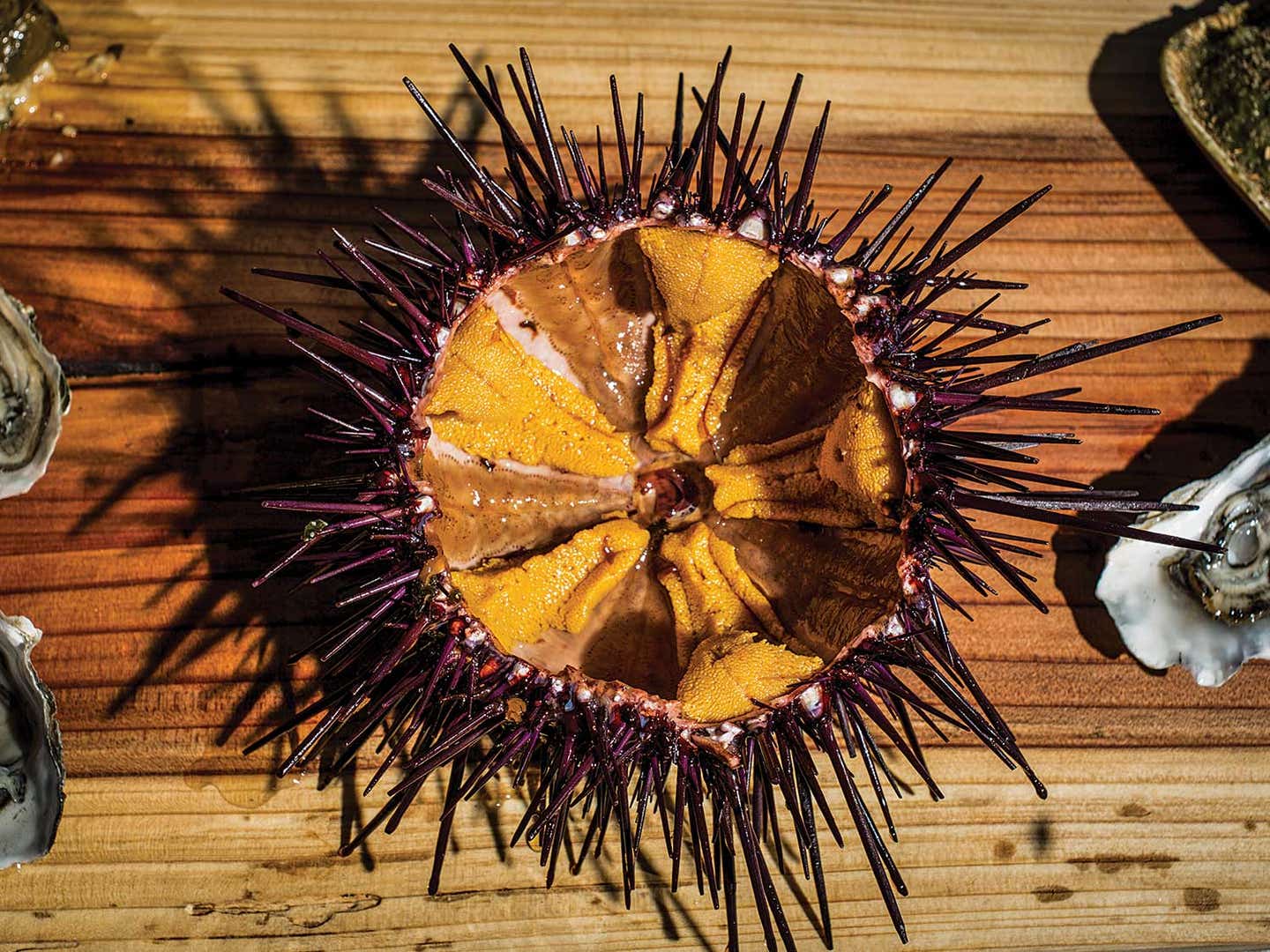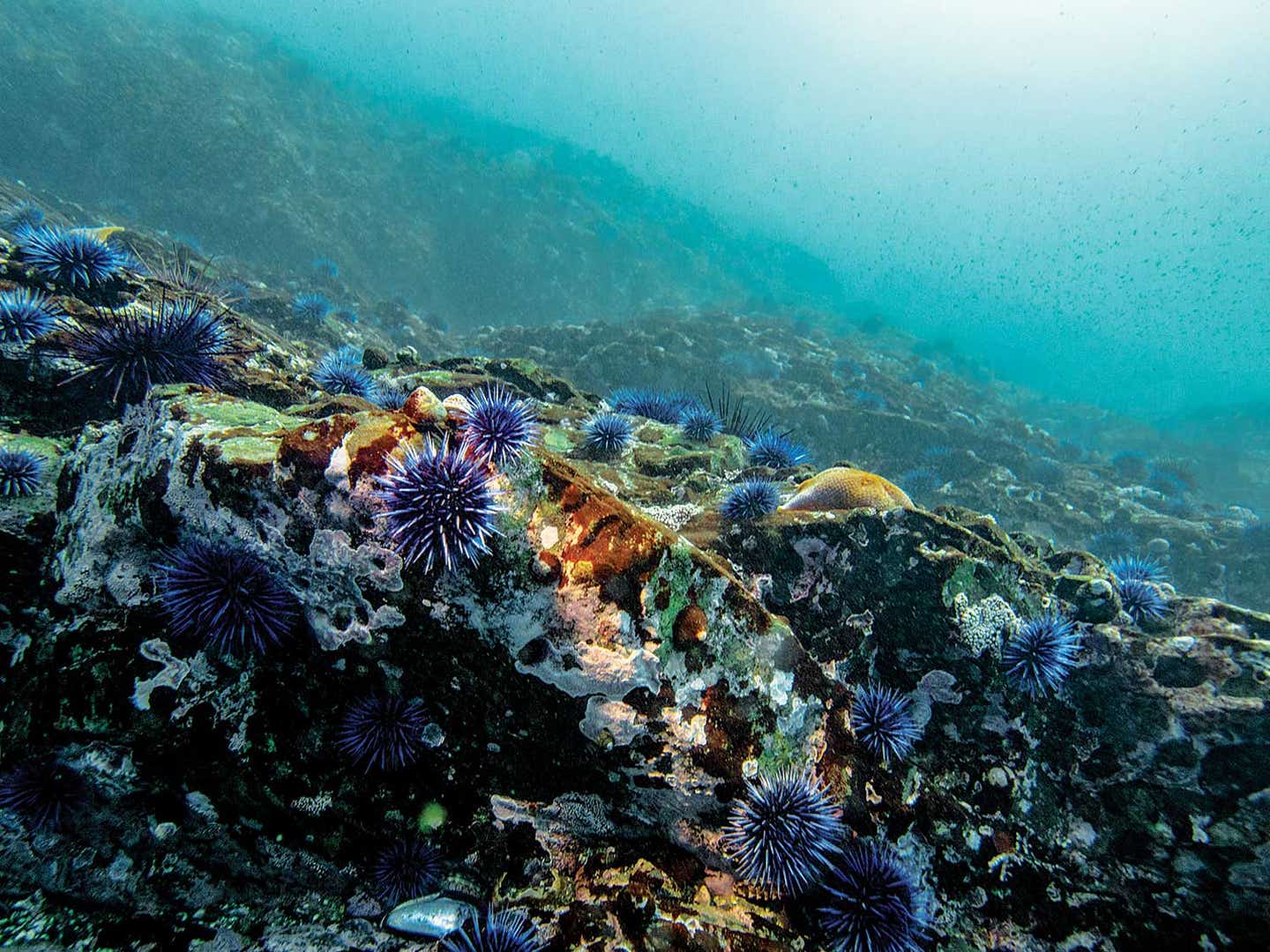
A Plague of Delicious Purple Urchins is Taking Over the California Coast and It’s Our Duty to Eat Them
What do you do when a favored delicacy becomes an unchecked epidemic? We might have some ideas…
We launch our kayaks at dawn from a pristine, sheltered cove and paddle about a quarter-mile up the pinnacle-studded Mendocino coastline to a craggy reef just offshore. Our mission is to scan the bottom of the Pacific for troublemakers, and we know we’re certain to find them. To prepare for my freedive, I float motionless on the surface and sink into the rhythm of my breathing: Inhale two counts, exhale slowly for 10, pause for two, repeat. A few rounds of this aquatic ujjayi slows my heart rate down to about 50 beats per minute. I take one last breath, filling my lungs top to bottom, before flipping upside down to begin my descent. A few fin strokes later, I join Jason Jaacks, an award-winning documentary filmmaker and photographer (and one of my closest friends), who is already near the ocean floor, capturing some establishing shots with a camera encased in crystalline plexiglass. I pause at a boulder, and over his shoulder spot a group of perch playing tag. A juvenile cabezon is perfectly camouflaged as a finny lump on a nearby bed of coralline algae, and a black rockfish is pecking at something invisible in a sandy crevice.
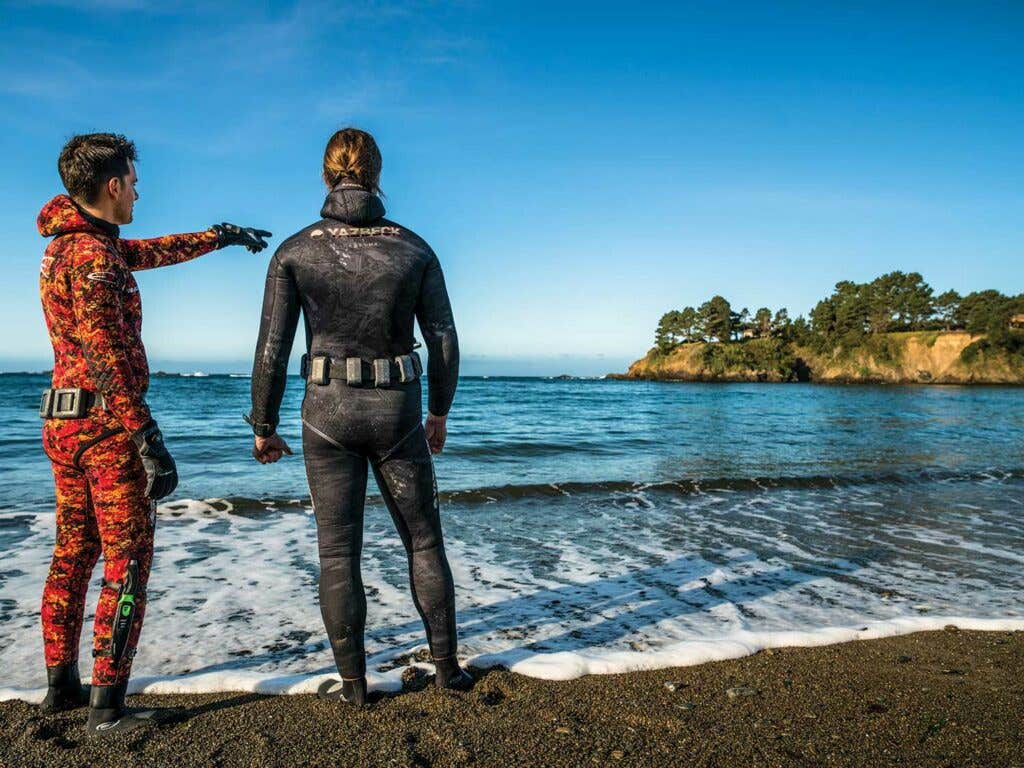
Above the water, Northern California is a forager’s paradise. The countryside is so abundant with wild edibles that even a year after a zombie apocalypse, you’d still be able to gather most of the ingredients needed to re-create whatever seasonal salad was trending around the Bay Area just beforehand with only hiking boots and some clippers. But with a snorkel and a wetsuit, it gets even better. After a single dive on the Sonoma-Mendocino coast, you can clamber back onto the beach carrying your weight in mussels, rock crab, gooseneck barnacles, Dungeness crab, abalone, rock scallops, nori, sea snails, and sea cucumbers. Even the water is a delicious, ready-made brine—a perfect court bouillon for poaching hand-harvested edible treasures. But something is missing here in this patch of ocean. Something is eerily off.
When I first started diving here, the area held towering forests of kelp, the fastest-growing organism on Earth. These underwater forests played a perfect parallel to the landlocked redwoods and coastal cypress that shelter the morels and wild fennel on shore. My friend Aaron Koseba taught me to freedive a few years ago when we were working on menu development for SingleThread, a Japanese-inflected wine-country restaurant in Healdsburg, California, and needed fresh ingredients for our trials. But Aaron and I have watched this coastline change at a breakneck pace over just a couple of years. Today, as Aaron and Jason trace the gentle slope of a massive pinnacle downward into a rift in the ocean floor more than 30 feet below me, everything they pass is choked with a spiky shag carpet of restless, clicking spines. There are no swaying fronds and firmly rooted kelp stalks, like the ones that anchor the rest of the Pacific Coast food chain. There are only the well-honed spikes of purple sea urchins, the shuffling, insatiable hordes responsible for this barren moonscape.
Massive environmental crises usually come with heartbreaking images of mountainous trash heaps, blackened factory smokestacks, and leaky, corroded barrels of toxic waste. But one of the biggest environmental threats these briny, idyllic waters has ever faced stems from something vibrantly purple-colored, pleasantly symmetrical, and stunningly delicious: urchins.
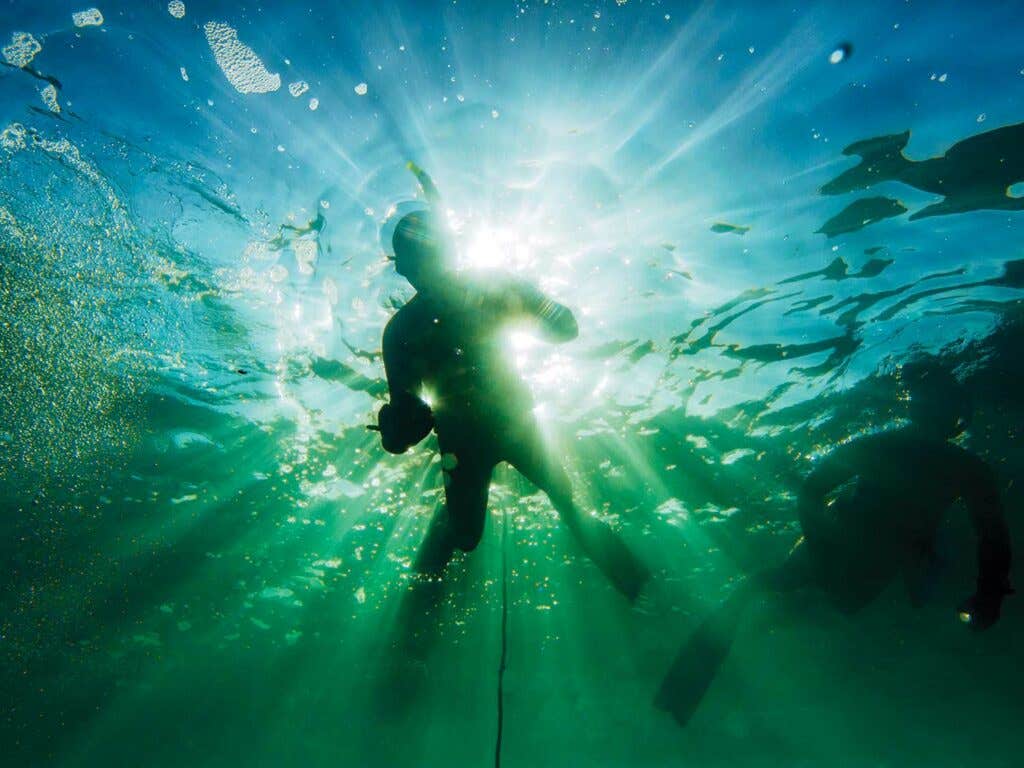
Sea urchins, the spiny, spherical relatives of sea stars and sea cucumbers, inhabit every ocean on Earth and can occupy territory from shallow tide pools to cavernous trenches miles below the surface. Years ago, before I started diving for them or cooking with their creamy reproductive organs (colloquially referred to as roe or by the Japanese as uni), I’d always assumed from sushi menu prices that urchins would be scarce, like truffles of the sea. This is true in some regions, such as the waters around Nova Scotia, where dwindling populations in recent years have made green urchins a precious, hard-to-come-by treasure. But today, on the West Coast, purple urchins are not. Like their larger, more commonly served red urchin cousins (which often look more purple-black than red), the purple Strongylocentrotus purpuratus flourish everywhere from Vancouver to Baja. Though their lovely colors may suggest otherwise, urchins are hardcore creatures: vaultlike orbs of reinforced calcium carbonate covered in hundreds of ball-and-socket-jointed spines that form a rippling conveyor system to drag food toward their rugged, five-toothed beaks. These marine wood chippers buzz around the ocean floor on legions of flexible tube feet that line their undersides. They feed mostly on algae but are opportunistic eaters, and their beaks can excavate everything from coral to rock to steel beams. Yet the coveted, edible sacks of pale orange roe within these living chambers—which taste like butter cultured from fresh, deep seawater—are as delicate and fragile as egg yolks. Members of a healthy, balanced community of urchins live fairly solitary lives. They burrow into crevices and dine on a varied diet of whatever scraps of decaying algae, animals, and plants the tide impales on their spines. When an urchin population explodes, however, as is likely to happen whenever climate change or other human-catalyzed chaos disrupts the local food chain, a distorted hive mind takes over. They congregate in subtidal hordes, actively consuming everything in their path, including the holdfast tissue that anchors kelp to rocks. Even after obliterating an entire kelp forest, urchins won’t eat themselves to extinction—they just switch back to munching on the tidal drift. A single one can also live for 70 years.
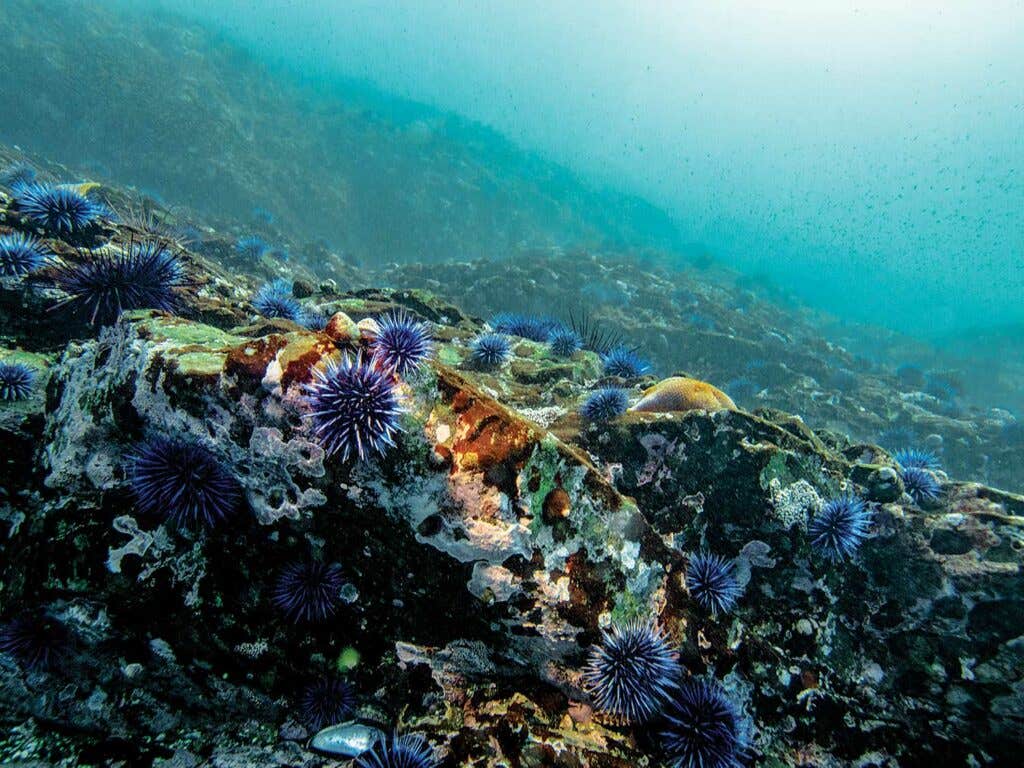
According to the California Department of Fish and Wildlife, over the past four years, about 90 percent of all coastal kelp from San Francisco to Oregon has been mowed down by a purple sea urchin population that is 6,000 percent larger than historic averages. This is, of course, at least partially our fault. Human-generated climate change is real, and warming ocean temperatures struck its first ecosystem-wide blow by weakening and thinning established kelp beds, which thrive on the rich nutrients available in cold, deep water. Add to that a brutal one-two punch of toxic red-tide algae and a sea-star-killing virus, and the urchins’ most effective natural predators have been effectively removed from the equation. Thriving kelp forests help anchor the bottom of the West Coast food chain by providing abundant sustenance and shelter to dozens of species. The barrens left in the urchins’ wake are bald, scarred ghost towns. The entire ecosystem is unmoored.
With the kelp gone, anything that tries to compete with the urchins for food is in serious trouble. Wild-caught abalone, which depend on kelp as a mainstay of their diet, are already off the menu—the CDFW closed recreational abalone fishing indefinitely late last year after the population plummeted due to starvation. Virtually all other nearshore West Coast fish and shellfish species that don’t directly feed on kelp but rely on kelp for shelter (or feed on those that do) are next in line. When the organisms that depend on kelp are knocked out, it will light a fire that blazes straight up the food chain.
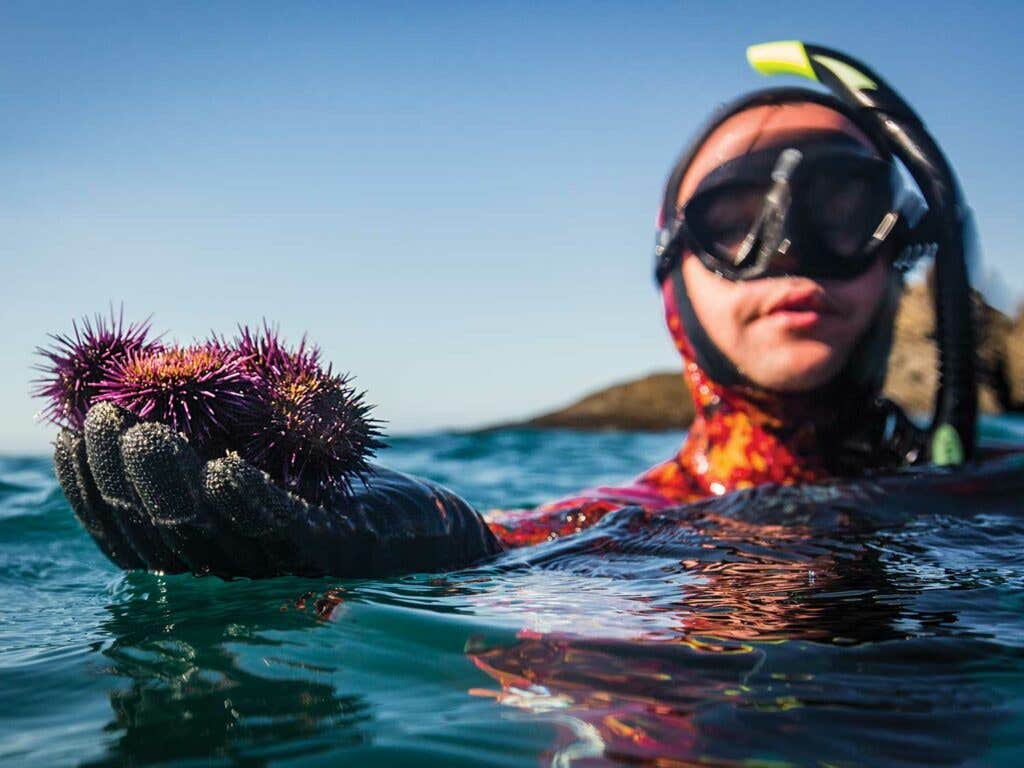
The situation seems bleak, but there is still hope for recovery. According to an article posted on the CDFW website, “The urchin barren conditions may persist until the presence of sufficient predators, disease, or storms reduce the exploding urchin population.” As the most effective predators the world has ever seen, we could be a part of the solution.
Hungry humans have successfully helped with this kind of problem before. Commercial urchin fisheries in the 1980s reversed several urchin barrens that had existed for decades, since we hunted sea otters—another urchin predator—nearly to extinction in the late 19th century. Apart from a couple of years in the early ’90s, when we sold nearly 700,000 pounds of purple urchins to chefs in Japan, commercial fisheries in the U.S. have historically focused on red urchins.
Purples are smaller than their red cousins, topping out at about 3 to 4 inches across, and typically yield smaller amounts of the edible roe. Still, purple urchin roe is some of the most delicate, unique, and versatile seafood in the world. Pair that with the fact that, as cooks, we’re more curious, creative, and resourceful in the kitchen than we’ve ever been, and a golden opportunity arises for cooks and consumers to go after purples. As of 2017, there were 300 licensed commercial urchin divers in California.
Unlike fish, sea urchins have no skin and therefore there is no barrier between ocean water and their tasty insides. In order to avoid becoming oceanic raisins from a life immersed in brine, urchins fortify themselves with a flavorful cocktail of savory, sweet, and salty amino acids, sugars, proteins, and minerals. In the kitchen, those proteins and lipids make uni a great thickener and emulsifier, and the amino acids and sugars help the roe caramelize when baked or roasted. The result is a multipurpose ingredient that, in terms of versatility, lands somewhere between roasted garlic, eggs, and avocados.
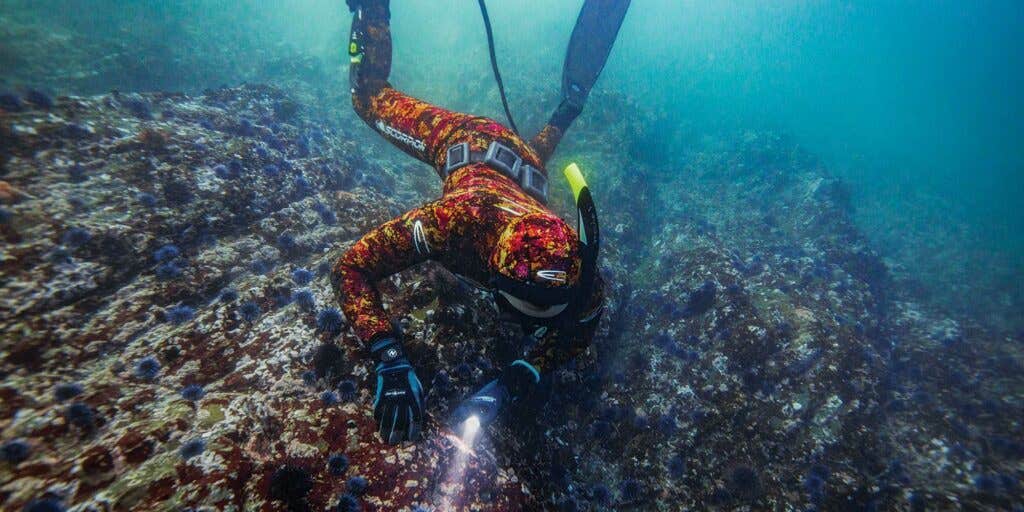
Here in Sonoma County, Aaron and the rest of SingleThread’s two-Michelin-starred crew have come up with dozens of ways to weave the unctuousness of uni into their dishes. Uni-enhanced ponzu and béchamel, enriched brioches and biscuits, and urchin-driven ferments are also appearing at restaurants such as the Willows Inn in Washington state and Smyth in Chicago. The creativity of these chefs in preserving sea urchins might also hold the key to transforming a fragile, perishable product into something more stable that can reach a wider audience. Imagine a fish sauce made from rendered uni that tastes like a deep, oaky shoyu of the sea; uni bottarga that can be shaved onto pasta like aged Parmesan; or uni vinegar. Lore has it that a French chef’s toque contains one fold for each method of cooking an egg. Sea urchins deserve their own hat.
Uni Beyond The Raw Bar
Whether you haul in a bounty of purple urchins yourself or order them from a supplier (which, for now, will likely be the larger, darker red urchins pictured on our cover), a glut means you might end up seeking out ways to eat the roe beyond raw. Chef Aaron Koseba suggests bruléeing it on toast to give it a caramelly crust, or baking it into brioche dough or gougères. You can also add uni to marinades or glazes, mount sauces with it, or whip it into an airy mousse.
Restaurant chefs are setting a great precedent for how to combat environmental crises through culinary ingenuity, and we can follow their lead. My mind drifts toward an idea for uni fondue as I catch my breath for a few minutes on the surface, a mesh bag bulging with about 20 urchins buckled around my waist. It took only three dives to get them, and my next breath is even more productive. As soon as I reach the bottom, I grab an urchin with each of my gloved hands. A doorknob-style twist is all it takes to pull them off the rock, and I snap them past the elastic band on my hip bag before grabbing three more from a short kelp stump. I feel my chest start to tighten with the urge to breathe, so I forgo the bag and start to pick urchins rapidly with my right hand and stack them like spiky coasters on my left arm. To keep from losing anything, I breach the surface belly-first like a large, graceless otter, and I pile 11 urchins into an empty space in my kayak. In just under an hour, Aaron, Jason, and I have each gathered all three of our legal daily urchin limits. While commercial divers harvest and sell purple urchins, even casual ocean enthusiasts can help: With a $48-per-year fishing license, anyone in California can grab 35 of them per day. It’s rare that a mushroom forager has that kind of luck.
Back at the cove where our day started, we haul everything onshore and empty the urchin bags into two aggressively worn coolers. Between a cookout tonight and some recipe testing tomorrow, this batch will be gone within 24 hours. But a few bucketfuls of fresh seawater will keep urchins alive and healthy for a couple of days.
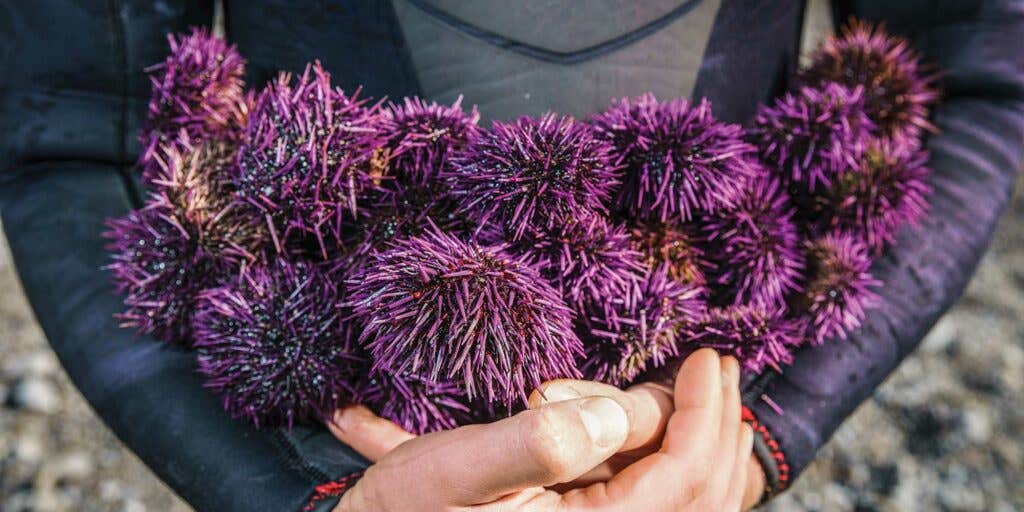
Eventually, the purple urchin mission will require restraint, as the frenzied swell of a food trend can easily spin out of control (see bluefin tuna, the Pacific population of which has dwindled to under 3 percent of its historical average). There’s nothing inherently evil or alien about sea urchins in these waters, and eating them to extinction would be just as catastrophic. We’ve developed successful systems for controlled feeding in other industries: In Sonoma and Mendocino, winemakers bring sheep into their vineyards in winter and spring to mow down tasty weeds between the rows. As the grapes appear, the sheep are shuffled on to other pastures before they can do any damage. We can learn from this inland finesse how to responsibly indulge in the abundance at hand in the sea.
Coastal authorities at any time might change regulations to allow recreational harvest and distribution of purple urchins in greater numbers, or—eventually—fewer. The situation is an ever-changing one. Right now, it’s our duty to eat massive quantities of one of the most exquisite delicacies on Earth, while always paying attention to the experts who will tell us when we’ve done our job and it’s time to move on to the next pasture.
Keep Reading
Continue to Next Story
